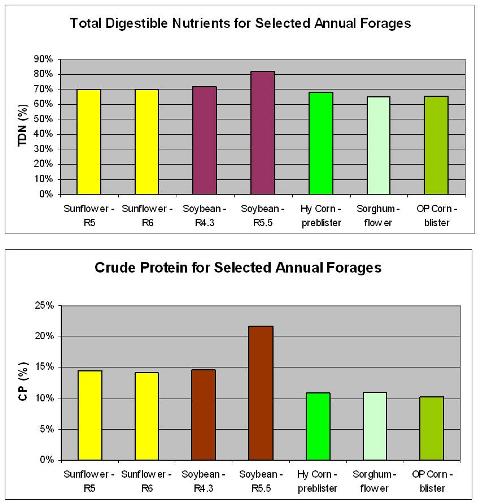Feed Opportunities for Livestock Producers - Feed Values of Long Season Crops
The 2010 crop year, although wetter than normal, appears to be on track in terms of growing degree days and crop heat accumulation. However, for long season crops such as sunflowers, soybeans and corn that have yet to reach physiological maturity, it is always good to have a Plan B in place for those “just in case” situations. Some livestock producers in the hardest hit areas of Manitoba might be interested in alternative feed options if those “just in case” situations arise, so we have assembled some feed values for immature long season crops.
Below is a relative comparison of feed values of sunflowers harvested at both R5 and R6 maturity stages, hybrid corn (Hy Corn) harvested at the preblister stage, open pollinated corn (OP Corn) harvested at the blister stage, sorghum harvested at flowering, and soybeans harvested at both the R4.3 and R5.5 maturity stages. These were harvested from a demonstration in early September. Measures of total digestible nutrients (TDN) and crude protein (CP) were conducted on a dry matter basis.
The samples show that energy content of all crops are sufficient for gestating beef cows, and that the protein content of sunflowers and soybeans are sufficient; however that of the hybrid corn, sorghum and open pollinated corn may need additional protein as cows enter into the third trimester. Caution should also be taken to monitor forage nitrate levels to avoid livestock poisoning – crops grown in high nitrogen soils are most at risk of livestock poisoning. Caution should also be taken when grazing soybeans as they can cause bloat, albeit less so than alfalfa and clovers. Avoid grazing mature soybean crops as the seeds contain trypsin inhibitors, which are dangerous for young ruminants (ie. calves) and monogastric animals. Older ruminants are not as susceptible.
If you are planning on harvesting your crop for silage, be sure it is harvested at the correct moisture level. Below are a number of links to former articles on moisture levels in silage. Also linked are articles on safe storage of dry hay.
If you plan on using your crop as forage, a forage test and proper ration balancing is recommended. Your local MAFRI office can help you test your feed and balance your ration.

Sunflowers: R5 = Flowering; R6 = Flowering is complete and ray flowers are wilting.
Soybeans: R4.3 = most advanced pods are >3/4 " long; R5.5 = seeds developing in most advanced pods.

